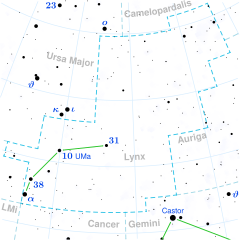10 Ursae Majoris
| Observation data Epoch J2000 Equinox J2000 | |
|---|---|
| Constellation | Lynx |
| Right ascension | 09h 00m 38.38067s[1] |
| Declination | +41° 46′ 58.6051″[1] |
| Apparent magnitude (V) | 3.960[2] (4.18 / 6.48)[3] |
| Characteristics | |
| Spectral type | F3V + K0V[4] |
| U−B color index | +0.04[2] |
| B−V color index | +0.43[2] |
| Astrometry | |
| Radial velocity (Rv) | 26.4 ± 0.9[5] km/s |
| Proper motion (μ) | RA: -474.31[1] mas/yr Dec.: -204.21[1] mas/yr |
| Parallax (π) | 62.23 ± 0.68 mas[1] |
| Distance | 52.4 ± 0.6 ly (16.1 ± 0.2 pc) |
| Orbit[6] | |
| Period (P) | 7691.0 ± 1.8 d |
| Semi-major axis (a) | 0.64566 ± 0.00056″ |
| Eccentricity (e) | 0.15075 ± 0.00084 |
| Inclination (i) | 131.366 ± 0.099° |
| Longitude of the node (Ω) | 203.74 ± 0.10° |
| Periastron epoch (T) | JD 2449263.1 ± 9.1 |
| Argument of periastron (ω) (secondary) | 32.30 ± 0.44° |
| Details[4] | |
| 10 UMa A | |
| Mass | 1.44 M☉ |
| Radius | 1.518[a] R☉ |
| Luminosity | 4.285 L☉ |
| Temperature | 6740 K |
| 10 UMa B | |
| Mass | 0.89 M☉ |
| Radius | 0.965[a] R☉ |
| Luminosity | 0.638 L☉ |
| Temperature | 5250 K |
| Other designations | |
| Database references | |
| SIMBAD | 10 UMa |
| ARICNS | 10 UMa A |
| 10 UMa B | |
10 Ursae Majoris is a binary star system in the northern constellation of Lynx. It is visible to the naked eye as a faint star with a combined apparent visual magnitude of 3.960.[2] This system is fairly close to the Sun, at 53 light-years (16.1 pc) away from Earth.[1] It is the third-brightest object in Lynx. Originally in the neighbouring constellation Ursa Major, it became part of Lynx with the official laying down of the constellation borders.[8] The system is moving further from the Earth with a heliocentric radial velocity of 26.4 km/s.[5] It is a probable member of the Hyades supercluster.[9]
This is a spectroscopic binary—orbital motion from the two stars can be detected by Doppler shifts in their spectra. In this case, the two stars can also be split by differential astrometry. The magnitude 4.18[3] primary has a mass of 1.44 M☉ and the fainter secondary, 0.89 M☉.[4] The primary is an F-type main-sequence star radiating 4.3 times the Sun's luminosity, and the magnitude 6.48[3] secondary is K-type with 0.6 times the luminosity of the Sun. The two orbit each other every 21.057 years with an eccentricity of 0.15.[6]
Notes
- ^ a b Calculated, using the Stefan-Boltzmann law and the star's effective temperature and luminosity, with respect to the solar nominal effective temperature of 5,772 K:
References
- ^ a b c d e f van Leeuwen, F.; et al. (2007). "Validation of the new Hipparcos reduction". Astronomy and Astrophysics. 474 (2): 653–664. arXiv:0708.1752. Bibcode:2007A&A...474..653V. doi:10.1051/0004-6361:20078357. S2CID 18759600.
- ^ a b c d Oja, T. (1991). "UBV photometry of stars whose positions are accurately known. VI". Astronomy and Astrophysics Supplement Series. 89 (2): 415–419. Bibcode:1991A&AS...89..415O.
- ^ a b c "Sixth Catalog of Orbits of Visual Binary Stars". United States Naval Observatory. Archived from the original on 1 August 2017. Retrieved 18 June 2017.
- ^ a b c Eggl, S.; Pilat-Lohinger, E.; Funk, B.; Georgakarakos, N.; Haghighipour, N. (2012). "Circumstellar habitable zones of binary-star systems in the solar neighbourhood". Monthly Notices of the Royal Astronomical Society. 428 (4): 3104. arXiv:1210.5411. Bibcode:2013MNRAS.428.3104E. doi:10.1093/mnras/sts257. S2CID 73534476.
- ^ a b Wilson, Ralph Elmer (1953). "General catalogue of stellar radial velocities". Washington. Bibcode:1953GCRV..C......0W.
- ^ a b Muterspaugh, Matthew W.; Hartkopf, William I.; Lane, Benjamin F.; o'Connell, J.; Williamson, M.; Kulkarni, S. R.; Konacki, Maciej; Burke, Bernard F.; Colavita, M. M.; Shao, M.; Wiktorowicz, Sloane J. (2010). "The Phases Differential Astrometry Data Archive. Ii. Updated Binary Star Orbits and a Long Period Eclipsing Binary". The Astronomical Journal. 140 (6): 1623. arXiv:1010.4043. Bibcode:2010AJ....140.1623M. doi:10.1088/0004-6256/140/6/1623. S2CID 6030289.
- ^ "10 UMa". SIMBAD. Centre de données astronomiques de Strasbourg. Retrieved April 27, 2019.
- ^ Bagnall, Philip M. (2012). The Star Atlas Companion: What You Need to Know about the Constellations. New York, New York: Springer. p. 281. ISBN 978-1-4614-0830-7.
- ^ Eggen, O. J. (June 1984). "A Systematic Search for Members of the Hyades Supercluster - Part Two - the Visual Binaries". Astronomical Journal. 89:6 (1541): 839. Bibcode:1984AJ.....89..839E. doi:10.1086/113579.
External links
Kaler, James B. "10 UMA (10 Ursae Majoris) = HR 3579 Lyncis". Stars. University of Illinois. Retrieved 9 March 2016.



